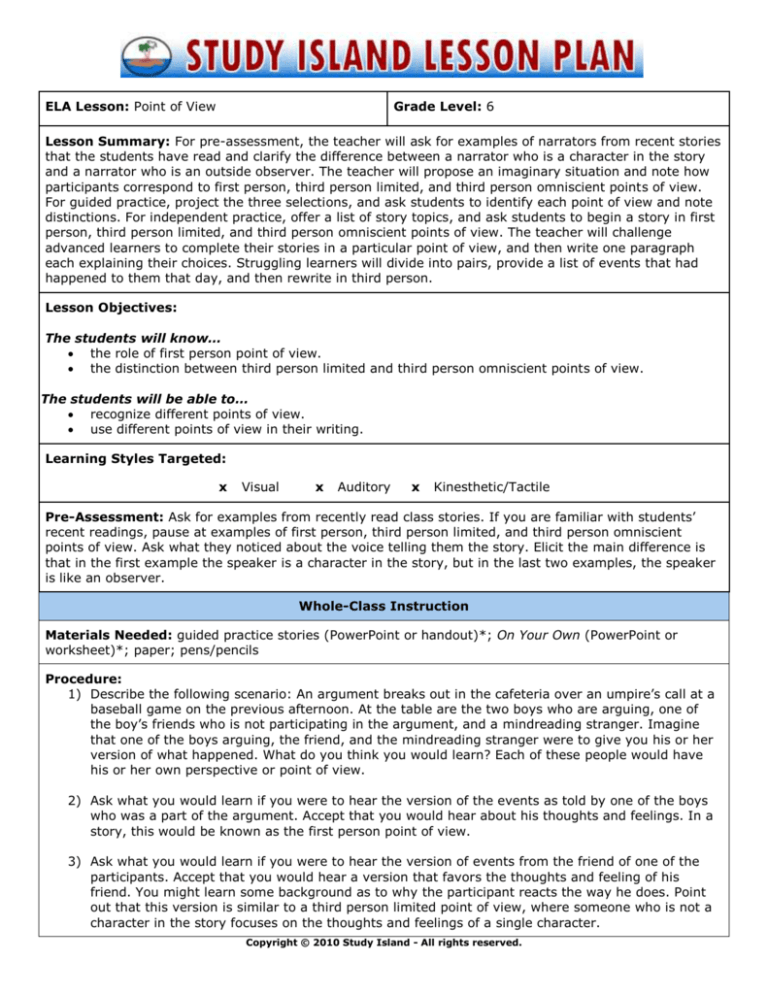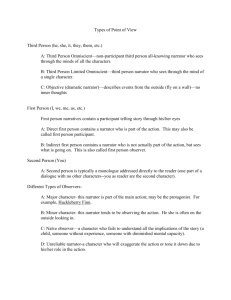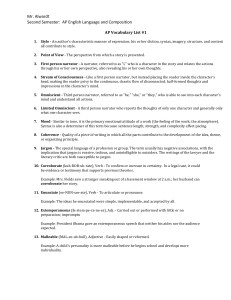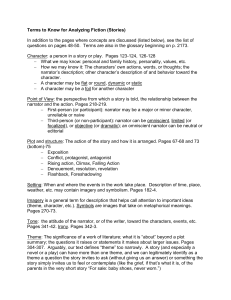
ELA Lesson: Point of View
Grade Level: 6
Lesson Summary: For pre-assessment, the teacher will ask for examples of narrators from recent stories
that the students have read and clarify the difference between a narrator who is a character in the story
and a narrator who is an outside observer. The teacher will propose an imaginary situation and note how
participants correspond to first person, third person limited, and third person omniscient points of view.
For guided practice, project the three selections, and ask students to identify each point of view and note
distinctions. For independent practice, offer a list of story topics, and ask students to begin a story in first
person, third person limited, and third person omniscient points of view. The teacher will challenge
advanced learners to complete their stories in a particular point of view, and then write one paragraph
each explaining their choices. Struggling learners will divide into pairs, provide a list of events that had
happened to them that day, and then rewrite in third person.
Lesson Objectives:
The students will know…
the role of first person point of view.
the distinction between third person limited and third person omniscient points of view.
The students will be able to…
recognize different points of view.
use different points of view in their writing.
Learning Styles Targeted:
x
Visual
x
Auditory
x
Kinesthetic/Tactile
Pre-Assessment: Ask for examples from recently read class stories. If you are familiar with students’
recent readings, pause at examples of first person, third person limited, and third person omniscient
points of view. Ask what they noticed about the voice telling them the story. Elicit the main difference is
that in the first example the speaker is a character in the story, but in the last two examples, the speaker
is like an observer.
Whole-Class Instruction
Materials Needed: guided practice stories (PowerPoint or handout)*; On Your Own (PowerPoint or
worksheet)*; paper; pens/pencils
Procedure:
1) Describe the following scenario: An argument breaks out in the cafeteria over an umpire’s call at a
baseball game on the previous afternoon. At the table are the two boys who are arguing, one of
the boy’s friends who is not participating in the argument, and a mindreading stranger. Imagine
that one of the boys arguing, the friend, and the mindreading stranger were to give you his or her
version of what happened. What do you think you would learn? Each of these people would have
his or her own perspective or point of view.
2) Ask what you would learn if you were to hear the version of the events as told by one of the boys
who was a part of the argument. Accept that you would hear about his thoughts and feelings. In a
story, this would be known as the first person point of view.
3) Ask what you would learn if you were to hear the version of events from the friend of one of the
participants. Accept that you would hear a version that favors the thoughts and feeling of his
friend. You might learn some background as to why the participant reacts the way he does. Point
out that this version is similar to a third person limited point of view, where someone who is not a
character in the story focuses on the thoughts and feelings of a single character.
Copyright © 2010 Study Island - All rights reserved.
4) Ask what you would learn if you were to hear the version of events as told by the mindreading
stranger at the table. Accept that this point of view would take into account all of the details of
what is going on and would focus on each of the characters involved. Point out that this is similar
to a third person omniscient point of view, where the narrator is not a character in the story, but
an objective observer of what is going on.
5) Distribute the guided practice handout* or project the first slide of the guided practice
PowerPoint*. Ask a gifted reader to read the adaptation from The Voyages of Dr. Doolittle. When
the reader has finished, ask the following questions:
Who is talking?
Accept that it is Dr. Doolittle or a man.
What is he talking about?
Accept that he reminiscing about when he was nine and a half and wanted to go to sea.
What point of view is this selection told from?
Accept that it is from the first person point of view.
6) Refer to the second selection on the handout, or project the second slide on the board. Ask a gifted
reader to read the adaptation of Little Men. When the reader has finished, ask the following
questions:
Who is talking?
Accept that it is a narrator.
What is the narrator talking about?
Accept that the narrator is talking about a young boy looking at a house.
What do we learn?
Accept that we learn what the boy is thinking and feeling as he approaches the house.
What point of view is this selection told from?
Accept that it is told from the third person limited point of view.
7) Refer to the second selection on the handout, or project the third slide on the board. Ask a gifted
reader to read the adaptation of Little Men. When the reader has finished, ask the following
questions:
Who is talking?
Accept that it is a narrator.
What is the narrator talking about?
Accept that the narrator is talking about four boys planting a garden.
What point of view is this selection told from?
Accept that it is from the third person omniscient point of view.
8) Handout copies of the On Your Own worksheet*, or display the On Your Own PowerPoint*. Go over
the directions, and ask students to complete the assignment.
9) If time permits, have students read their stories aloud and comment on the advantages of each
point of view.
Advanced Learner
Materials Needed: paper; pens/pencils
Procedure:
1) Challenge students to add more to their stories from using one point of view. After they have
finished, ask students to write a short paragraph each explaining the advantages and
disadvantages of their point-of-view choices.
Copyright © 2010 Study Island - All rights reserved.
2) If time permits, have students exchange stories. Have each student comment on his or her
partner’s choice of point of view.
Struggling Learner
Materials Needed: paper; pens/pencils
Procedure:
1) Explain to students that they are going to write a series of events in first person point of view and
then change them to the third person point of view. To demonstrate, write a pair of sentences in
the first person point of view about what you did this morning. As a group, rewrite the sentences in
the third person point of view.
2) Break students into pairs. First, ask students to describe a series of events that happened to them
since they arrived at school that day.
3) Then ask students to swap. Ask the partners to retell the series of events from the point of view of
a third person narrator. Guide students with sentence beginnings such as “John’s day began when .
. . .” Discuss and review their work.
4) Have students complete the On Your Own* activity.
*see supplemental resources
Copyright © 2010 Study Island - All rights reserved.










